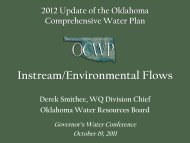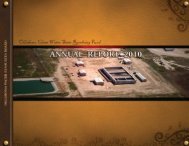Basic Hydrology - Water Resources Board
Basic Hydrology - Water Resources Board
Basic Hydrology - Water Resources Board
Create successful ePaper yourself
Turn your PDF publications into a flip-book with our unique Google optimized e-Paper software.
Introduction to <strong>Hydrology</strong><br />
OKLAHOMA STATE UNIVERSITY<br />
Biosystems and Agricultural Engineering Department<br />
<strong>Basic</strong>s of <strong>Hydrology</strong>:<br />
A 45-minute Spiel on <strong>Water</strong><br />
Garey Fox, Ph.D., P.E.<br />
Assistant Professor<br />
Biosystems and Agricultural Engineering<br />
Oklahoma State University<br />
<strong>Basic</strong> <strong>Water</strong> Science Seminar<br />
May 14, 2009
Introduction to <strong>Hydrology</strong><br />
OKLAHOMA STATE UNIVERSITY<br />
Biosystems and Agricultural Engineering Department<br />
Hydrologic Cycle<br />
Movement of water on and under the earth’s land surfaces,<br />
and the physical, chemical and biological processes<br />
accompanying that movement<br />
Global annual average water<br />
balance if 100 units of<br />
precipitation fell on land<br />
(Source: Chow, Maidment,<br />
and Mays, Applied<br />
<strong>Hydrology</strong>, 1988)
Introduction to <strong>Hydrology</strong><br />
OKLAHOMA STATE UNIVERSITY<br />
Biosystems and Agricultural Engineering Department<br />
Where is the water?<br />
Oceans 96.5<br />
Ground <strong>Water</strong><br />
Fresh<br />
Saline<br />
% Total <strong>Water</strong> % Fresh <strong>Water</strong><br />
0.76<br />
0.93<br />
30.1<br />
Soil Moisture 0.0012 0.05<br />
Polar Ice 1.7 68.6<br />
Lakes<br />
Fresh<br />
Saline<br />
0.007<br />
0.006<br />
0.26<br />
Rivers 0.0002 0.006<br />
Source: Chin, D.A. <strong>Water</strong> <strong>Resources</strong> Engineering, 2000.
Introduction to <strong>Hydrology</strong><br />
OKLAHOMA STATE UNIVERSITY<br />
Biosystems and Agricultural Engineering Department<br />
<strong>Water</strong> Balance Equations<br />
• Primary conservation law in hydrology is mass<br />
balance:<br />
P + G<br />
in<br />
− ( Q + ET<br />
I<br />
+ G<br />
− Q<br />
out<br />
= ΔS<br />
) = ΔS
Introduction to <strong>Hydrology</strong><br />
OKLAHOMA STATE UNIVERSITY<br />
Biosystems and Agricultural Engineering Department<br />
Surface <strong>Water</strong><br />
• What variables are used<br />
to describe surface<br />
water?<br />
– Lakes/Reservoirs:<br />
• Stage (ft or m)<br />
• Total Storage (acre-feet<br />
or ft 3 or m 3 )<br />
– Rivers/Streams:<br />
• Stage (ft or m)<br />
• Discharge, Q (cfs, cms)<br />
• Velocity (ft/s or m/s)<br />
Honey Creek near Grove, OK
Introduction to <strong>Hydrology</strong><br />
OKLAHOMA STATE UNIVERSITY<br />
Biosystems and Agricultural Engineering Department
Introduction to <strong>Hydrology</strong><br />
OKLAHOMA STATE UNIVERSITY<br />
Biosystems and Agricultural Engineering Department<br />
Surface <strong>Water</strong><br />
• Surface <strong>Water</strong> usually managed on basis of<br />
watersheds:<br />
– <strong>Water</strong>shed (Drainage basin, Catchment) –<br />
topographic area that collects and discharges stream<br />
flow through one outlet<br />
– Divide<br />
– Basin Outlet
Introduction to <strong>Hydrology</strong><br />
OKLAHOMA STATE UNIVERSITY<br />
Biosystems and Agricultural Engineering Department<br />
Surface <strong>Water</strong><br />
Source:<br />
Mays, <strong>Water</strong><br />
<strong>Resources</strong><br />
Engineering, 2001<br />
http://www.owrb.state.ok.us/maps/pdf_map/okwater.pdf
Introduction to <strong>Hydrology</strong><br />
OKLAHOMA STATE UNIVERSITY<br />
Biosystems and Agricultural Engineering Department<br />
• Note the nested<br />
hierarchy of lowerorder<br />
basins within<br />
a larger drainage<br />
basin…<br />
Surface <strong>Water</strong><br />
Source:<br />
Mays, <strong>Water</strong><br />
<strong>Resources</strong><br />
Engineering, 2001
Introduction to <strong>Hydrology</strong><br />
OKLAHOMA STATE UNIVERSITY<br />
Biosystems and Agricultural Engineering Department<br />
• Streams are<br />
classified in a basin<br />
by ordering the flow<br />
network…<br />
Stream Order<br />
Source:<br />
Mays, <strong>Water</strong><br />
<strong>Resources</strong><br />
Engineering, 2001
Introduction to <strong>Hydrology</strong><br />
OKLAHOMA STATE UNIVERSITY<br />
Biosystems and Agricultural Engineering Department<br />
Hydrologists use Statistics…<br />
• Hydrologic statistics <br />
Frequency Analysis<br />
• Hydrologic systems are impacted<br />
by extreme events (floods,<br />
droughts)<br />
– Magnitude of extreme event is<br />
inversely related to its frequency<br />
of occurrence<br />
– Very extreme events occur less<br />
frequently than moderate events
Introduction to <strong>Hydrology</strong><br />
OKLAHOMA STATE UNIVERSITY<br />
Biosystems and Agricultural Engineering Department<br />
Return Period<br />
– Return Period (T) = average recurrence interval between<br />
events equaling or exceeding a specific magnitude<br />
– There is NO REGULARITY expected with a T-year event<br />
– In a T-year period we may have more than one T-year event<br />
1971<br />
1975<br />
1976<br />
1977<br />
1992<br />
1995<br />
2001<br />
2006<br />
4 yrs<br />
1 yr<br />
1 yr<br />
15 yrs<br />
3 yrs<br />
6 yrs<br />
5 yrs<br />
= 35<br />
T<br />
35 yrs<br />
=<br />
7<br />
= 5 years
Introduction to <strong>Hydrology</strong><br />
OKLAHOMA STATE UNIVERSITY<br />
Biosystems and Agricultural Engineering Department<br />
– Infiltration – movement<br />
of water from soil<br />
surface into the soil<br />
• 76% of the world’s land<br />
area precipitation<br />
infiltrates<br />
• Highly dependent on<br />
surface cover<br />
• Question: What causes<br />
water to infiltrate into the<br />
soil?<br />
Infiltration
Introduction to <strong>Hydrology</strong><br />
OKLAHOMA STATE UNIVERSITY<br />
Biosystems and Agricultural Engineering Department<br />
Infiltration
Introduction to <strong>Hydrology</strong><br />
OKLAHOMA STATE UNIVERSITY<br />
Biosystems and Agricultural Engineering Department<br />
Infiltration<br />
– Infiltration rate in general is governed by:<br />
• Soil physical properties (Soil Texture, Bulk Density):<br />
• Hydraulic conductivity<br />
• Vegetative cover<br />
• Antecedent moisture content<br />
• Rainfall intensity<br />
• Slope<br />
– True or False?<br />
• A wet soil has a lower infiltration rate than a dry soil.
Introduction to <strong>Hydrology</strong><br />
OKLAHOMA STATE UNIVERSITY<br />
Biosystems and Agricultural Engineering Department<br />
Infiltration<br />
– Soil Texture and Hydraulic Conductivity:<br />
Typical K<br />
(cm/day)<br />
Sand 700<br />
Loamy Sand 346<br />
Loam 17<br />
Silt Loam 8<br />
Silt 4<br />
Clay 3
Introduction to <strong>Hydrology</strong><br />
OKLAHOMA STATE UNIVERSITY<br />
Biosystems and Agricultural Engineering Department<br />
Evaporation/Evapotranspiration<br />
– Evapotranspiration –<br />
• Evaporation of liquid water from rivers and lakes, bare<br />
soil, and vegetative surfaces<br />
• Evaporation from within the leaves of plants<br />
(transpiration)<br />
– Generally not significant for individual storms but<br />
can be over long periods of time…<br />
• Globally, about 62% of precipitation that falls on<br />
continents is evapotranspired
Introduction to <strong>Hydrology</strong><br />
OKLAHOMA STATE UNIVERSITY<br />
Biosystems and Agricultural Engineering Department<br />
Potential ET<br />
• Potential ET (PET)<br />
– ET for a well-watered reference crop<br />
(turf grass or alfalfa)<br />
• PET depends on the evaporative<br />
demand of the atmosphere<br />
– PET affected by:<br />
• air temperature<br />
• relative humidity<br />
• solar radiation<br />
• wind speed
Introduction to <strong>Hydrology</strong><br />
OKLAHOMA STATE UNIVERSITY<br />
Biosystems and Agricultural Engineering Department<br />
Actual ET<br />
• Actual ET depends on:<br />
– PET<br />
– Plant species<br />
– Plant growth stage<br />
– Soil moisture<br />
• In dry conditions, a plant will close its<br />
stomata in order to retain water<br />
ET = K × K × ET a c r
Introduction to <strong>Hydrology</strong><br />
OKLAHOMA STATE UNIVERSITY<br />
Biosystems and Agricultural Engineering Department<br />
Runoff<br />
– Rainfall Excess – also called effective rainfall<br />
(rainfall neither retained on land surface or<br />
infiltrated)<br />
– Goal of runoff models Determine surface runoff<br />
from watersheds due to particular storm<br />
• Rainfall/runoff Analysis
Introduction to <strong>Hydrology</strong><br />
OKLAHOMA STATE UNIVERSITY<br />
Biosystems and Agricultural Engineering Department<br />
Runoff<br />
– Amount of runoff depends on land cover<br />
• Can be quantified through runoff coefficient…<br />
Description<br />
Runoff Coefficient<br />
Pavement:<br />
Asphalt, Concrete 0.70-0.95<br />
Lawns, sand soil:<br />
2% (Flat)<br />
>7% (Steep)<br />
Residential:<br />
Single Family<br />
Apartments<br />
0.05-0.10<br />
0.15-0.20<br />
0.30-0.50<br />
0.50-0.70
Introduction to <strong>Hydrology</strong><br />
OKLAHOMA STATE UNIVERSITY<br />
Biosystems and Agricultural Engineering Department<br />
Hydrographs<br />
Source:<br />
Mays, <strong>Water</strong> <strong>Resources</strong> Engineering, 2001
Introduction to <strong>Hydrology</strong><br />
OKLAHOMA STATE UNIVERSITY<br />
Biosystems and Agricultural Engineering Department<br />
Hydrographs<br />
Source:<br />
Mays, <strong>Water</strong> <strong>Resources</strong> Engineering, 2001
Introduction to <strong>Hydrology</strong><br />
OKLAHOMA STATE UNIVERSITY<br />
Biosystems and Agricultural Engineering Department<br />
Hydrographs<br />
Source:<br />
Mays, <strong>Water</strong> <strong>Resources</strong> Engineering, 2001
Introduction to <strong>Hydrology</strong><br />
OKLAHOMA STATE UNIVERSITY<br />
Biosystems and Agricultural Engineering Department<br />
Hydrographs
Introduction to <strong>Hydrology</strong><br />
OKLAHOMA STATE UNIVERSITY<br />
Biosystems and Agricultural Engineering Department<br />
Mid and Large-Size <strong>Water</strong>sheds<br />
– Shape of the hydrograph depends on the temporal<br />
distribution of rainfall…<br />
Source:<br />
Mays, <strong>Water</strong> <strong>Resources</strong> Engineering, 2001
Introduction to <strong>Hydrology</strong><br />
OKLAHOMA STATE UNIVERSITY<br />
Biosystems and Agricultural Engineering Department<br />
Mid and Large-Size <strong>Water</strong>sheds<br />
– Shape of the hydrograph depends on the spatial<br />
distribution of rainfall…<br />
Source:<br />
Mays, <strong>Water</strong> <strong>Resources</strong> Engineering, 2001
Introduction to <strong>Hydrology</strong><br />
OKLAHOMA STATE UNIVERSITY<br />
Biosystems and Agricultural Engineering Department<br />
Mid and Large-Size <strong>Water</strong>sheds<br />
– Shape of the hydrograph depends on the spatial<br />
distribution of rainfall…<br />
Source:<br />
Mays, <strong>Water</strong> <strong>Resources</strong> Engineering, 2001
Introduction to <strong>Hydrology</strong><br />
OKLAHOMA STATE UNIVERSITY<br />
Biosystems and Agricultural Engineering Department<br />
Ground <strong>Water</strong><br />
• Aquifer - geologic formation that CONTAINS<br />
sufficient saturated porous material and<br />
CONDUCTS water in useable quantities
Introduction to <strong>Hydrology</strong><br />
OKLAHOMA STATE UNIVERSITY<br />
Biosystems and Agricultural Engineering Department<br />
Ground <strong>Water</strong><br />
• Ground water usually managed as basins:<br />
– Ground <strong>Water</strong> Basin – group of aquifers<br />
linked together in a larger flow system<br />
About 30% of world’s<br />
total freshwater<br />
About ¼ of all water used<br />
for domestic water use,<br />
irrigation and industrial<br />
uses is from ground water<br />
Ground water is the<br />
source of most water in<br />
rivers and lakes (base<br />
flow)<br />
http://www.owrb.state.ok.us/maps/pdf_map/major_aquifers.pdf
Introduction to <strong>Hydrology</strong><br />
OKLAHOMA STATE UNIVERSITY<br />
Biosystems and Agricultural Engineering Department<br />
Aquifer Properties<br />
• CONDUCTS – how fast can water move<br />
through the porous media?<br />
– Hydraulic Conductivity<br />
• Rate of flow of water through a unit area of porous<br />
material under a unit hydraulic gradient<br />
• Question: Which has the higher hydraulic<br />
conductivity?<br />
(a) Sand<br />
(b) Clay
Introduction to <strong>Hydrology</strong><br />
OKLAHOMA STATE UNIVERSITY<br />
Biosystems and Agricultural Engineering Department<br />
Aquifer Properties<br />
• STORAGE - how much water can an aquifer<br />
hold?<br />
• Question: Which has the higher storage capacity?<br />
(a) Sand<br />
(b) Clay<br />
– Specific Yield – volume of water drained from a<br />
saturated sample by gravity<br />
• Generally only applies to an unconfined aquifer<br />
– Storage Coefficient – volume of water the aquifer<br />
releases from storage per unit decline in head<br />
• Applies to both confined and unconfined aquifers
Introduction to <strong>Hydrology</strong><br />
OKLAHOMA STATE UNIVERSITY<br />
Biosystems and Agricultural Engineering Department<br />
Well Pumping<br />
• Drawdown – distance water level or<br />
piezometric surface is lowered
Introduction to <strong>Hydrology</strong><br />
OKLAHOMA STATE UNIVERSITY<br />
Biosystems and Agricultural Engineering Department<br />
Alluvial Aquifers
Introduction to <strong>Hydrology</strong><br />
OKLAHOMA STATE UNIVERSITY<br />
Biosystems and Agricultural Engineering Department<br />
Pumping next to River<br />
•<strong>Water</strong> pumped from ground can capture…<br />
1. <strong>Water</strong> that would have contributed base flow to a<br />
stream<br />
2. Create leakage from the stream into the aquifer
Introduction to <strong>Hydrology</strong><br />
OKLAHOMA STATE UNIVERSITY<br />
Biosystems and Agricultural Engineering Department<br />
Key U.S. <strong>Water</strong> <strong>Resources</strong> Agencies<br />
• U.S. Geological Survey (USGS) – primary source for streamflow<br />
and ground water data in the United States (www.usgs.gov)<br />
• U.S. Environmental Protection Agency (EPA) – responsible for<br />
implementation and enforcement of environmental laws<br />
(www.epa.gov)<br />
• U.S. Natural <strong>Resources</strong> Conservation Service (NRCS) – works with<br />
landowners on private lands to conserve natural resources<br />
(www.nrcs.usda.gov)<br />
• U.S. Army Corps of Engineers (USACE) – responsible for planning,<br />
construction, operation, and maintenance of a variety of waterresource<br />
facilities (www.usace.army.mil)<br />
• U.S. Bureau of Reclamation (USBR) – manages water-related<br />
resources west of the Mississippi River (www.usbr.gov)
Introduction to <strong>Hydrology</strong><br />
OKLAHOMA STATE UNIVERSITY<br />
Biosystems and Agricultural Engineering Department<br />
Questions?<br />
It is always a great day to be a<br />
hydrologist!





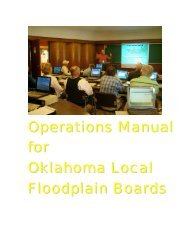
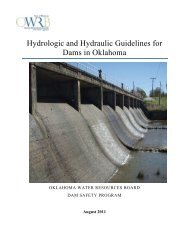
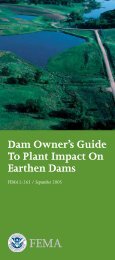

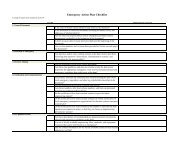
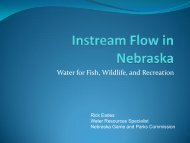

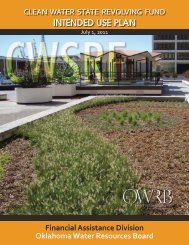

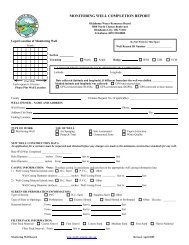
![A Commodity & a Resource [pdf] - Water Resources Board - State of ...](https://img.yumpu.com/42536671/1/190x143/a-commodity-a-resource-pdf-water-resources-board-state-of-.jpg?quality=85)
